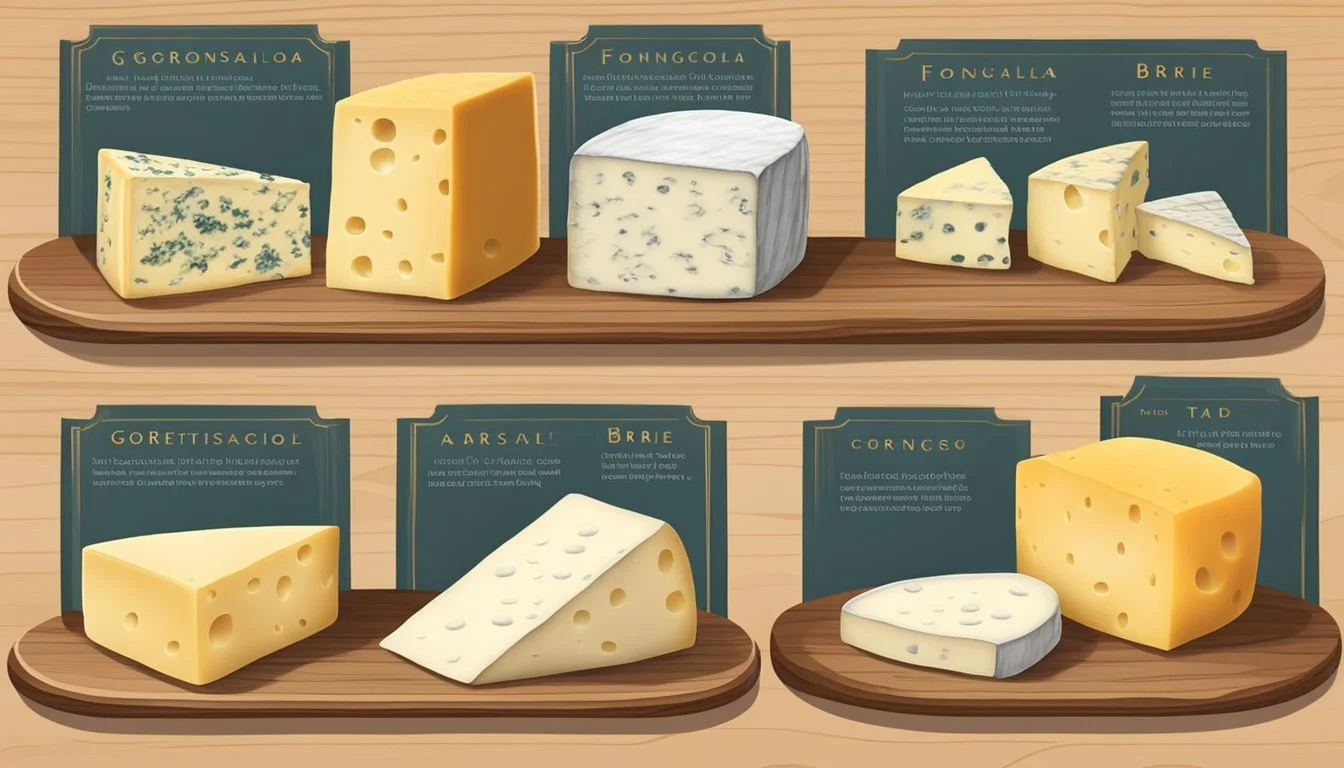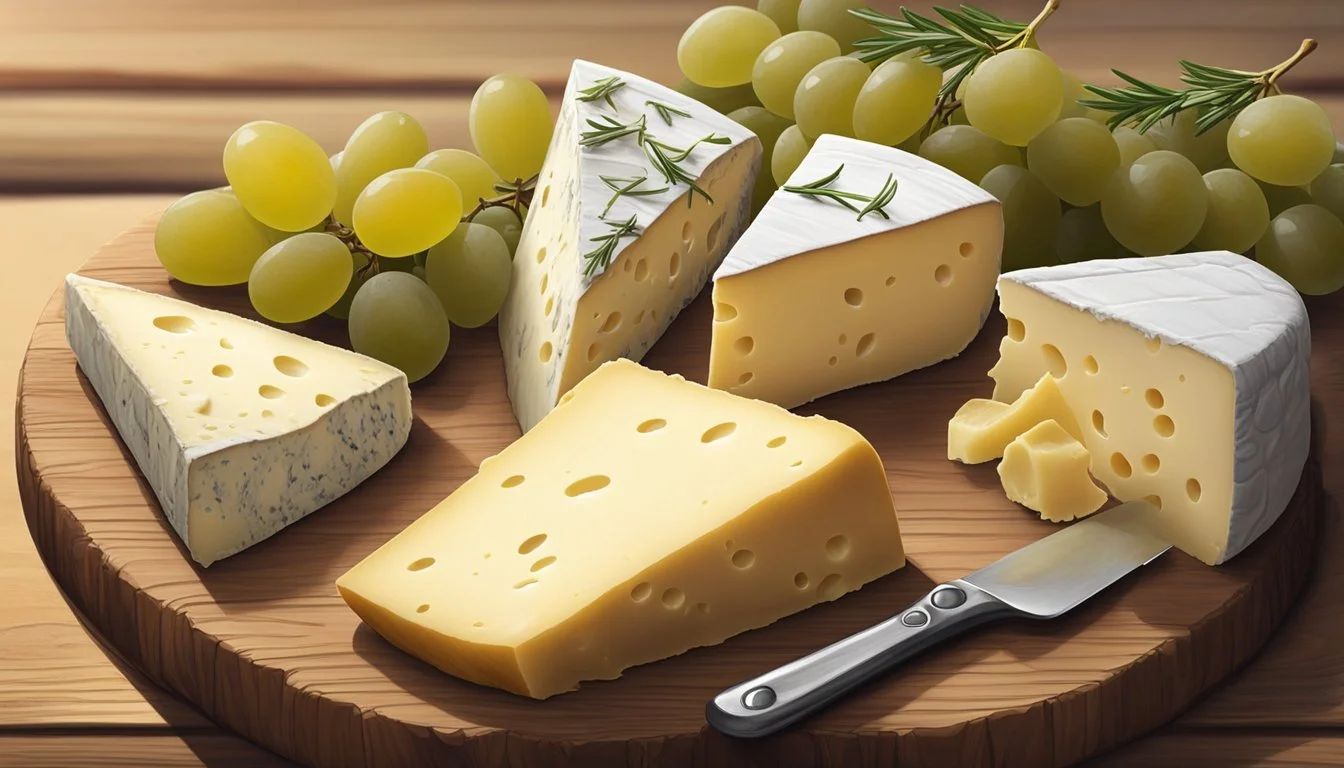Taleggio Cheese Substitutes
Top Alternatives for Every Dish
Finding a substitute for Taleggio cheese that matches its unique characteristics can be a challenge, but several alternatives come close in flavor and texture. One of the best substitutes for Taleggio cheese is Fontina, known for its nutty and buttery flavor that melts beautifully, making it ideal for various recipes.
Another highly recommended option is Pont-l'Évêque, a French cheese with a similar creamy texture and tangy notes. For those seeking a milder alternative, Havarti offers a buttery profile with excellent melting properties.
By exploring these substitutions, home cooks can still enjoy the creamy, rich taste that Taleggio brings to dishes, even when the original isn't available.
Understanding Taleggio Cheese
Taleggio is an Italian cheese that has been produced for centuries, named after the Val Taleggio region in Lombardy.
This semi-soft cheese is made from cow’s milk and is known for its pungent aroma.
The cheese features a washed-rind, which is generally pinkish-orange in color.
The interior of Taleggio is a creamy pale yellow and has a smooth texture.
The rind is edible and contributes a slightly earthy flavor to the cheese.
Taleggio is often appreciated for its tangy and unique taste, making it a popular addition to various recipes.
The aroma might be strong, but the taste remains relatively mild and creamy.
This cheese melts easily, making it ideal for dishes like risottos, pastas, and fondues.
Key Characteristics of Taleggio Cheese
Taleggio cheese is valued for its distinctive texture, aroma, and flavor. Understanding these elements can help you appreciate why it's a favorite among food enthusiasts.
Texture and Aroma
Taleggio has a semi-soft texture that feels creamy and buttery on the palate. Its rind is washed, giving it a moist and slightly sticky exterior. The interior exhibits a pale yellow color with a smooth consistency that makes it easy to spread or melt.
The cheese's aroma is notably pungent, with earthy and mushroom-like notes. This distinct smell can be attributed to the aging process, which involves regular washing with brine. Despite its strong scent, the texture remains invitingly soft and tender.
Flavor Profile
The flavor of Taleggio cheese is complex and layered. It combines a mild tanginess with rich, buttery undertones. There is also a pronounced savory element, adding depth to its taste. Mildly sweet and slightly salty, the cheese can have an earthy flavor that becomes more intense with aging.
These characteristics make Taleggio versatile in culinary applications, enhancing both savory and sweet dishes. From sandwiches to sauces, its unique flavor profile contributes a sophisticated touch, making it a beloved ingredient in many recipes.
Best Taleggio Cheese Substitutes
When seeking alternatives to Taleggio cheese, it is crucial to find substitutes that closely mimic its creamy texture, tangy flavor, and rich aroma. Fontina, Brie, and Gorgonzola are some excellent choices that can replicate these characteristics effectively.
Fontina: A Versatile Substitute
Fontina is a semi-soft cheese known for its earthiness and buttery flavor. Originating from Italy, Fontina has a firm yet creamy texture. This makes it a versatile substitute for Taleggio cheese.
Fontina melts beautifully, making it perfect for dishes like sauces, fondue, and grilled cheese sandwiches. The cheese's sweet and nutty notes pair well with a variety of ingredients, enhancing the overall taste of your recipes.
Brie: Creamy and Buttery Alternative
Brie is a popular French cheese that offers a creamy and buttery texture, quite similar to Taleggio. Brie has a mild flavor with a hint of tanginess that complements its smooth consistency.
This cheese is often used in gourmet recipes, from baked dishes to charcuterie boards. Its soft rind and creamy interior create a delightful contrast, making it a perfect substitute in recipes that call for Taleggio.
Gorgonzola: Adding a Tangy Touch
Gorgonzola, especially the Dolce variety, provides a tangy twist to your dish. This Italian blue cheese is softer and creamier than its more aged counterpart. Gorgonzola Dolce has a sweet and nutty flavor underpinned by a tangy finish.
Its creamy texture and distinctive taste add depth to recipes, particularly in salads, creamy pasta dishes, and gourmet pizzas. Use this cheese to introduce a sharp and tangy element to your cooking.
Other Noteworthy Substitutes
Bel Paese: This Italian semi-soft cheese offers a mild, creamy flavor similar to Taleggio. It's great for melting.
Havarti: Known for its buttery taste and excellent melting qualities, Havarti can be a wonderful alternative in various dishes.
Gruyère: Gruyère’s nutty and slightly sweet flavor works well in baked dishes and gratins.
Camembert: Similar to Brie, Camembert is creamy with a slightly more intense flavor profile.
Pont-l’Évêque: A French option with a soft, creamy center and a pungent aroma, ideal for those who enjoy the tangy notes of Taleggio.
These substitutes offer a range of flavors and textures, providing versatility in your culinary creations.
Considerations When Choosing a Substitute
When selecting a substitute for Taleggio cheese, focus on flavor compatibility, melting properties, and the suitability of the cheese for specific recipes.
Flavor Compatibility
The flavor profile of Taleggio is both tangy and creamy with a mild, buttery taste. When choosing an alternative, consider whether the substitute provides a similar balance of flavors.
Grayson cheese offers a milder flavor but has a stronger smell. Havarti is another option with a milder, buttery flavor and great melting qualities.
Bel Paese provides a creamy, milky flavor similar to Mozzarella, making it versatile. Pont-l'Évêque cheese has a tangy note, making it a good match for Taleggio's tanginess. Each substitute brings its unique flavor, so choose one that enhances your specific dish.
Melting Properties
Taleggio cheese melts well, making it ideal for dishes like risottos and pasta. When seeking a substitute, it's essential to consider the melting properties of the cheese.
Havarti and Grayson cheese are known for their excellent melting abilities, making them suitable for pizzas and quiches.
Robiola is another exceptional choice, offering a creamy consistency perfect for melting. Bel Paese also melts wonderfully and can be used in a variety of hot dishes. The cheese’s melting characteristics should complement the dish's texture and consistency.
Recipe Suitability
The chosen cheese substitute must work well in the specific recipes you are preparing. Taleggio pairs well with items like pizzas, risottos, pasta dishes, quiches, and soups.
Grayson cheese and Havarti can be used in these dishes, providing the necessary creamy texture and mild flavor. Pont-l'Évêque is great for recipes that benefit from its tangy notes.
Bel Paese and Robiola are versatile enough for diverse culinary applications including cooking, baking, and fresh preparation. Select a cheese that enhances your culinary creations while maintaining a resemblance to Taleggio's essence.
Pairing Substitutes With Foods
Substituting Taleggio cheese provides many options that can be paired deliciously with various foods. Here are some pairings to enhance your culinary experience:
Bel Paese, with its mild and creamy flavor, pairs well with crusty bread and fresh fruit. It's excellent for making sandwiches or adding a delicate taste to salads.
Pont-l'Évêque
With a pungent aroma and creamy texture, Pont-l'Évêque complements crackers and cured meats. It's a popular choice for cheese platters, offering a tangy note that pairs well with fruits and nuts.
Grayson Cheese
This American Taleggio-style cheese has a strong smell and milder flavor. It's perfect for cheeseboards with an array of crusty bread, fruits, and cured meats. Its melting properties make it ideal for warm sandwiches.
Havarti Cheese
Havarti's buttery texture and superb melting abilities make it great for sandwiches, fall salads, and nuts. Adding slices to grilled sandwiches or melting it over crackers is a popular use.
Robiola
Robiola's smooth, creamy consistency is perfect for spreading on bread or crackers. It can be paired with a variety of cured meats and fresh fruits. Use it in recipes requiring a meltable cheese for an extra creamy touch.
Switching Taleggio for Feta in salads or roasted vegetable dishes can add a Mediterranean flair. Its crumbly texture goes well with nuts and fresh fruits, enhancing the overall flavor profile.
Taleggio Substitutes in Various Cuisines
Finding a substitute for Taleggio cheese in different cuisines can be crucial to maintaining the desired flavors and textures in a dish. Here are some potential substitutes, each with its unique characteristics:
Pont-l'Évêque: This soft French cheese offers a creamy texture and mild pungent smell, making it ideal for recipes needing that earthy flavor mixed with tangy notes.
Fontina: Originating from Italy's Aosta Valley, Fontina shares a nutty and buttery flavor profile. It melts easily, making it perfect for savory dishes like fondue or Italian pasta dishes.
Grayson: This American Taleggio-style cheese is milder in flavor but has a stronger aroma. It's useful in dishes where the smell enhances the eating experience without overpowering other ingredients.
Using a substitute can affect the dish's flavor profile:
Dish Substitute Flavor Note Italian Pasta Fontina Nutty, creamy, enhances compatibility Cheese Platters Pont-l'Évêque Slightly sweet, tangy, and mild pungent Grilled Cheese Havarti Buttery with excellent melting properties
Other substitutes emphasize different flavors:
Urgelia Cheese: Spanish cheese with a saltier flavor, suitable for sharper taste requirements.
Feta Cheese: Provides a savory and slightly sharper edge, good for Mediterranean dishes.
Each substitute offers unique advantages depending on the cuisine and specific dish. Careful choice ensures the distinctive flavor of Taleggio is either preserved or uniquely enhanced.
Cultural and Historical Considerations
Taleggio cheese, hailing from the Val Taleggio region in Lombardy, Italy, is steeped in tradition and culinary significance. Its origins and historical production methods play a crucial role in understanding its cultural importance.
Origin of Taleggio Cheese
Taleggio cheese originates from the Val Taleggio region in Lombardy, Italy. This semi-soft, washed-rind cheese has been crafted in the region since the 9th century.
The natural caves of Val Taleggio provided the perfect environment for aging the cheese, contributing to its unique flavor profile. These caves offered ideal humidity and temperature conditions, which are vital for the development of the cheese's characteristic rind and tangy taste.
Over the centuries, cheesemakers in Lombardy have perfected the craft of making Taleggio. The use of indigenous cows' milk and meticulous aging processes are key aspects of its traditional production. This heritage not only maintains the cheese's authenticity but also connects present-day production with ancient practices.
Culinary History
The culinary history of Taleggio cheese is rich and varied, reflecting its long-standing importance in Italian cuisine. For centuries, it has been an integral part of local culinary traditions in Lombardy.
Originally, Taleggio was a staple food for farmers who needed a nutritious and energy-dense product. Its creamy texture and pungent aroma made it suitable for a variety of dishes, from simple bread pairings to more complex recipes.
Through generations, the traditional methods of Taleggio production have been passed down, preserving its unique taste and quality. Its application in cuisine has also expanded over time. Today, it is enjoyed globally, thanks to its ability to melt beautifully and add depth to dishes, highlighting its enduring culinary relevance.
Health and Nutritional Information
Taleggio cheese, a product of cow's milk, brings both flavor and nutritional benefits. It is important to consider its caloric content, specific nutritional values, and dietary restrictions.
Caloric Content and Nutritional Values
Taleggio cheese is relatively high in calories. A typical serving size of about 100 grams contains around 320-360 calories. This makes it a rich source of energy, largely due to its fat content.
Nutritionally, Taleggio provides several significant elements:
Protein: Approximately 20-25 grams, essential for muscle maintenance and growth.
Fat: Around 28-30 grams, with a mix of saturated and unsaturated fats.
Calcium: High levels, supporting bone health.
Vitamins: Contains A, B2 (riboflavin), and B12.
Besides these, Taleggio, as a washed-rind cheese, offers beneficial bacteria like Brevibacterium linens which contribute to gut health.
Dietary Restrictions
For those with dietary restrictions, Taleggio cheese might pose challenges. As a product from cow’s milk, it is unsuitable for those with lactose intolerance or milk allergies. While aged cheeses often have reduced lactose, careful consumption is still advised.
Vegetarians should note that traditional Taleggio uses animal rennet for coagulation. Seeking varieties made with microbial rennet can be a good alternative.
Additionally, individuals adhering to low-calorie diets may want to moderate their intake due to its caloric density. Pregnant women should avoid Taleggio made from raw cow’s milk to prevent exposure to harmful bacteria.
In summary, understanding the nutritional values and potential dietary limitations of Taleggio cheese ensures it can be enjoyed sensibly and healthily in various diets.
Taleggio and Wine Pairing
Taleggio cheese benefits from pairing with specific wines that enhance its creamy texture and earthy flavors.
White Wines:
Sauvignon Blanc – Its acidity cuts through the richness of Taleggio.
Chardonnay – Especially unoaked, it complements the cheese's creamy nature.
Riesling – A slightly sweet Riesling balances the tanginess of Taleggio.
Red Wines:
Pinot Noir – Its light body and fruity notes work well with Taleggio's mild pungency.
Barbera – High acidity and berry flavors elevate the earthy taste of the cheese.
Merlot – Soft tannins and a velvety texture enhance the cheese's creamy characteristics.
Special Pairings:
Sparkling Wines: Champagne or Prosecco, with their effervescence, add a refreshing contrast.
Sweet Dessert Wines: Moscato or Sauternes complement the cheese with their sweetness and balance the tangy notes.
Wine pairing with Taleggio offers a range of delightful options. Experimenting with these suggestions can lead to discovering personal favorites.









